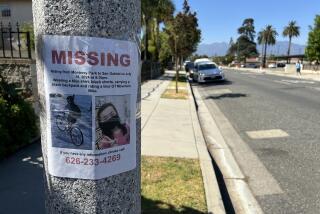L.A. Breathes Easier as It Hands Off Smog Title
The Los Angeles Basin has been dethroned as the Smog Capital of the U.S.--at least for 1999.
This year is the first in more than five decades without full-scale smog alert conditions anywhere in the region. Also, for the first time, another U.S. city has claimed the title as the smoggiest place in the nation.
Houston, by all indicators, has had a worse year, experiencing 44 days when ozone levels exceeded national health standards--one more day than the Los Angeles region. The Texas city’s ozone peaked Thursday at 0.251 parts per million--equivalent to a Stage 1 smog alert. The highest such reading in the Los Angeles Basin this season, recorded in June, was substantially lower--0.17 parts per million--enough to trigger a health advisory but no alert.
Barry Wallerstein, executive officer of the South Coast Air Quality Management District, was clearly pleased that the century is ending on such a high note.
“We believe Houston has overtaken us. . . . We don’t take any joy in Houston having high levels, but it’s nice not to have the highest readings here,” he said.
Air quality experts, however, stress that they aren’t yet ready to declare a winner and a loser in the smog wars. Weather is critical to smog formation, and conditions can vary so much that it takes three to five years to confirm a trend in air quality.
“I’m not impressed yet. Levels can go up and down from one year to the next,” said Bryan Lambeth, meteorologist with the Texas Natural Resources Conservation Commission. “I suspect both areas are going to seesaw back and forth.”
Most of the credit for this year’s relatively light smog in the Los Angeles region goes to weather conditions, although continuing reductions in smog-forming emissions also helped. Air quality in Southern California has been steadily improving because the region has the toughest anti-smog rules in the world, regulating everything from automobiles and motorcycles to hair spray and paint.
In contrast, Houston’s air pollution declined in the late 1980s but has remained at about the same level over the last five to 10 years. It hasn’t worsened, Lambeth said, but it hasn’t improved either.
“Certainly there’s plenty of evidence that conditions are getting better in Los Angeles,” he said. “And if the improvement is faster in Los Angeles than it is in Houston, then Houston may actually have worse pollution levels--not because Houston is getting worse, but because Los Angeles got so much better.”
Houston’s highest ozone reading came Oct. 7--the day after the Texas city beat Los Angeles in a competition for a new professional football team.
“People are saying the good thing is we got their team; the bad thing is we got their air,” said Patrick Crimmins, a spokesman for the Texas conservation commission.
Texans joke that they should name their new team the Houston Haze.
“Maybe their team should come out here for preseason,” suggested Wallerstein. “The air’s cleaner.”
Cleanest Season Since World War II
In August and September, Houston had a severe stretch of hot, stagnant conditions that encourage the formation of ozone, the primary ingredient of smog. Meanwhile, the Los Angeles Basin had unusually good conditions throughout the summer. Cooler temperatures, cloudy days and moist sea breezes kept smog levels relatively low.
By all accounts, the 1999 smog season in Los Angeles, Orange, San Bernardino and Riverside counties was extraordinary--cleaner than any other since World War II, AQMD officials say. The region had 12 days of health advisories, compared with 43 last year and 28 in 1997.
During a health advisory, susceptible people--especially those with asthma or other lung or heart ailments--are advised to avoid outdoor activities, while healthy people are urged to avoid prolonged or vigorous exercise outdoors. A Stage 1 smog alert is more severe, with susceptible people advised to stay indoors and others warned to avoid any vigorous exercise outdoors.
AQMD officials and environmentalists warn that Southern California is still a long way away--at least 11 years--from air that is consistently safe to breathe regionwide. The federal government’s health standards have been violated somewhere in the basin, on average, once every four days this smog season.
The AQMD has been under fire from environmental groups and the U.S. Environmental Protection Agency for easing its efforts over the past few years to adopt new anti-smog regulations for businesses and other pollution sources.
A federal judge is expected to soon force the AQMD to adopt 30 rules outlined in a 1994 smog plan that the agency had deemed impractical or too expensive. In an attempt to avoid the judicial action, the AQMD is now planning to amend a newer smog plan, accelerating the adoption of some regulations and adding new ones.
Wallerstein said Southern Californians, especially in the business community, “should be congratulated” for the progress made so far.
“Given our population growth, if we can create a downward trend, then [Houston] ought to be able to do likewise,” he said.
The vast majority of emissions in the Los Angeles region come from cars, trucks and other vehicles. In fact, if all polluting industries--including the region’s dozen oil refineries--left, Los Angeles air would still violate health standards. Houston has even more petrochemical plants, and they play a major role in contributing to the area’s smog.
“Los Angeles has at least twice as many people, but probably less than half as much industrial emissions,” the Texas commission’s Lambeth said.
Texas officials suspect that Houston’s smog reading was so high Thursday because of some type of unreported release of fumes from a chemical plant or oil refinery. It was the highest ozone level recorded in Houston in 10 years. Even without that reading, however, Houston still would have recorded the nation’s peak for the season.
Ozone--a potent gas that inflames airways and lungs--is created when hydrocarbons and nitrogen oxides waft into the air and bake under the sun in a photochemical reaction.
The air in downtown Los Angeles has violated health standards only one day this year, compared with 36 in the San Bernardino Mountains town of Crestline and three in the eastern San Gabriel Valley. Orange County has had no violations this year. Riverside County has had three. Because emissions from vehicles and businesses in Los Angeles and Orange counties move east, they are the major reason that the Inland Empire has a more severe problem.
The region’s smoggiest air in recent years has shifted from Glendora in the San Gabriel Valley to Crestline, meaning that the worst concentrations are away from the urban core and in the sparsely populated mountains.
Smog alerts in the Los Angeles region have been officially recorded only since 1976, but pollution levels were so high from the late 1940s through the 1960s that experts say they would have been frequent then.
Southern California’s smog season runs from May through October, while Houston’s can continue into November, so its tally of smoggy days could keep climbing, while Los Angeles’ is unlikely to do so.
L.A.? No, It’s Houston
Number of days exceeding federal health standards for air:
Houston: 44 days
Los Angeles Basin: 43 days
Highs and Lows of Smog Days
Days of first-stage smog alerts-- when air is deemed very unhealthful-- have declined dramatically in the Los Angeles Basin in the past years and reached zero this year.
Stage 1 Alerts:
A Stage 1 smog alert is triggered when ozone reaches a “very unhealthful” concentration of 0.220 parts per million. Children, the elderly and people with lung disease are warned to stay indoors and all others are advised to curtail outdoor activities.
Smog alert days:
1977: 121
1978: 116
1979: 120
1980: 101
1981: 99
1982: 63
1983: 84
1984: 97
1985: 83
1986: 79
1987: 66
1988: 77
1989: 54
1990: 41
1991: 447
1992: 41
1993: 24
1994: 23
1995: 14
1996: 7
1997: 1
1998: 12
1999: 0
Source: South Coast Air Quality management District
More to Read
Sign up for Essential California
The most important California stories and recommendations in your inbox every morning.
You may occasionally receive promotional content from the Los Angeles Times.






